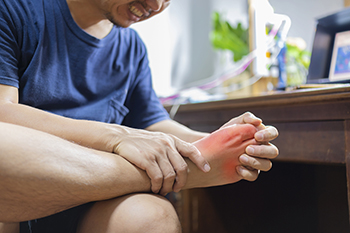Ankle discomfort can manifest as pain, stiffness, swelling, bruising, redness, tingling, or an inability to put weight on the ankle. There are several possible causes of ankle pain with the most common being sprains and strains of the ankle’s ligaments, and fractures of one or more bones in the ankle. Achilles tendon ruptures are another possible cause of ankle pain. They can occur when the Achilles tendon tears away from the heel bone which can cause swelling, bruising, and pain in the ankle. Rheumatoid arthritis, where the body’s immune system attacks the lining on the inside of the joint capsule, can occur in the ankle joint and be quite painful. Another form of arthritis—gout—causes a painful buildup of hardened uric acid crystals to deposit on joints, which can occur not only in the big toe, but the ankle joint as well. A bacterial infection (sometimes referred to as septic arthritis) may also set in the ankle joint, causing cartilage and bone damage, and pain. It is highly suggested that you seek the care of a podiatrist to determine the source and receive treatment for any ankle pain or discomfort you may be experiencing.
Ankle pain can be caused by a number of problems and may be potentially serious. If you have ankle pain, consult with one of our podiatrists from Advanced Foot & Ankle Medical Center . Our doctors will assess your condition and provide you with quality foot and ankle treatment.
Ankle pain is any condition that causes pain in the ankle. Due to the fact that the ankle consists of tendons, muscles, bones, and ligaments, ankle pain can come from a number of different conditions.
Causes
The most common causes of ankle pain include:
- Types of arthritis (rheumatoid, osteoarthritis, and gout)
- Ankle sprains
- Broken ankles
- Achilles tendinitis
- Achilles tendon rupture
- Stress fractures
- Bursitis
- Tarsal tunnel syndrome
- Plantar fasciitis
Symptoms
Symptoms of ankle injury vary based upon the condition. Pain may include general pain and discomfort, swelling, aching, redness, bruising, burning or stabbing sensations, and/or loss of sensation.
Diagnosis
Due to the wide variety of potential causes of ankle pain, podiatrists will utilize a number of different methods to properly diagnose ankle pain. This can include asking for personal and family medical histories and of any recent injuries. Further diagnosis may include sensation tests, a physical examination, and potentially x-rays or other imaging tests.
Treatment
Just as the range of causes varies widely, so do treatments. Some more common treatments are rest, ice packs, keeping pressure off the foot, orthotics and braces, medication for inflammation and pain, and surgery.
If you have any questions, please feel free to contact our office located in Thousand Oaks, CA . We offer the newest diagnostic and treatment technologies for all your foot care needs.






